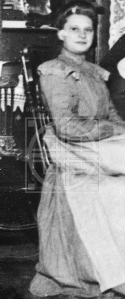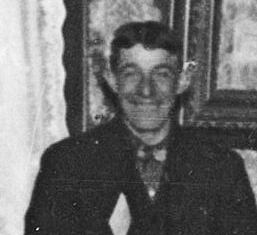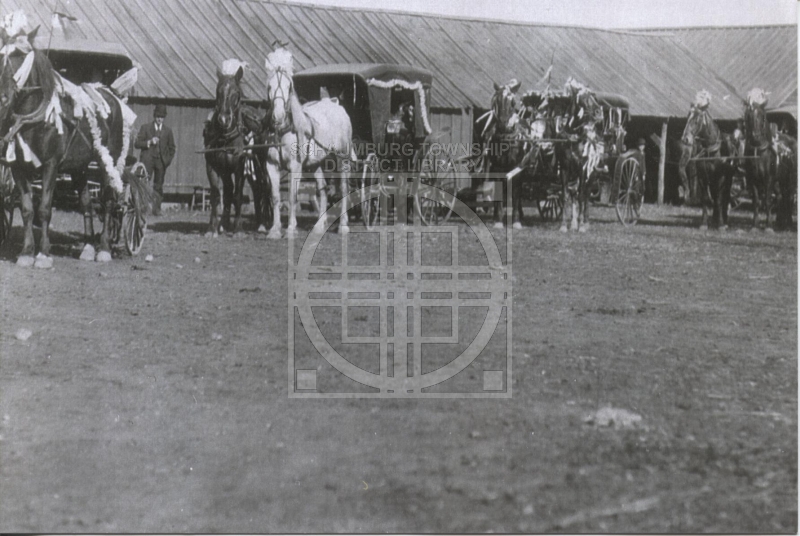In April 2011 I wrote a blog posting about the large wedding between Fred Pfingsten and Emma Rohlwing that occurred on September 3, 1903. It was quite an event, and was so big and festive that it was written up in the Chicago Inter Ocean magazine. That accounting has stood the test of time and continues to pop up in the German history of Schaumburg Township.
However, while doing a bit of research I recently stumbled on yet another large wedding that occurred just two years later in 1905. Mr. Henry Lichthardt and Miss Lucy Oltendorf were united in marriage at St. Peter’s Lutheran Church in Schaumburg Township at 11:00 a.m. on Thursday, September 7, 1905. (Notice it wasn’t a Saturday or even a weekend day!)
The wedding was a three day event and so big it was reported in not only the Palatine Enterprise but the Duluth News-Tribune, Fort Wayne Journal Gazette, Freeport Daily Journal, Sandusky Star Journal and Oakland Tribune to name a few. Clearly, word got around.
Both the bride and groom each had four attendants at the 11:00 A.M. service: Fred Lichthardt, Della E. Oltendorf, Louis Oltendorf, Martha Rohlwing, Louis Nerge, Sarah Schunemann, Edward Leiseberg and Alma Lichthardt. The bride wore a blue silk dress trimmed in Battenburg lace and carried a bouquet of “bride’s roses” while her bridesmaids were dressed in white and carried pink roses. Interesting how over the years the color of the dresses has reversed. (Unfortunately, we do not have a wedding photo of the bride and groom. The following photos were extrapolated from a larger photo from the Pfingsten collection.)
After the service, a long procession of carriages carried the wedding party, family and guests to the home of the groom’s parents, Johann and Engel Lichthardt. Their farm was two miles south of the church and the gaily decorated carriages that stretched for a mile must have been a sight. One team of horses “was literally covered with gay plumes and rosettes of fancy ribbons.” They were led by the Bartlett Blue Ribbon Band in a wagon pulled by a 4-horse team. This was followed by the bride’s wagon carrying the wedding party, and also drawn by a 4-horse team. Five more rigs carrying the flower girls and additional family members were next in the procession. (Below is an example of a local wedding procession that took place in 1909.)
Henry and Lucy invited over 250 families–which equaled nearly 1000 relatives and friends. Four large tents were erected in order to accomodate a buffet meal, dining, cards and dancing. Mrs. Hartmann was the caterer and oversaw the cooking while other ladies from the township helped serve the meals. The food on hand included: 1200 pounds of meat, five barrels of sauerkraut, 160 pounds of head cheese (a type of sliced cold cut that includes bits of pork jelled with a delicious broth and firmed in a mold), three tubs of potato salad, 50 kegs of beer and 100 gallons of gooseberry shrub. This latter item was also served at the Rohlwing/Pfingsten wedding and, according to one of the commenters below, seems to have been a drink that was possibly fermented.
The dining tent could hold 150 people while the card tent was set up with tables for games of pinochle. The dancing tent was 50×80 feet and covered with a smooth dancing floor specially laid for the occasion. The Bartlett Blue Ribbon Band proved its worth yet again by providing the music for the dancers.
Yet another piece of enjoyment for the bride and groom was the opportunity to take a ride in a new 25 horsepower automobile driven to the festivities by Louis Althen, president of the Elgin Brewing Company. He gave them a ride at top speed around the township.
Obviously, not everyone could fit in the tents so the large lawn of well mown grass and the orchard provided other relaxing options for the many guests. By all accounts the weather was gorgeous and in full cooperation for the three days. Who could ask for anything more?
Mr. and Mrs. Lichthardt began their married life at a new house on their 140 acre farm. Love must have been in the air during those three days in September 1905 because Mrs. Licthardt’s sister, Della, married Mr. Licthardt’s brother, Fred, a mere one year later on November 1, 1906!
Jane Rozek
Local History Librarian
Schaumburg Township District Library
jrozek@stdl.org
[Accountings used in the writing for this blog posting came from the September 7, 1905 Duluth News-Tribune and the September 8, 1905 Palatine Enterprise.]



This post is wonderful!
That would be a lot of people for a wedding today. Could not imagine how far some of those people traveled. That also would be a lot of horses and wagons for 1,000 people. Excellent article.
Jane, there are recipes for shrub drinks on a few websites. It is made with fruit, vinegar & sugar, as a concentrate, then later liquid is added with ice. It sounds refreshing!
Thank you Joan! The fact that there were “gallons” of gooseberry shrub certainly seems to confirm the drink you make note of. I appreciate the comment.
Jane Rozek
Local History Librarian
Schaumburg Township District Library
One of our local readers had these interesting comments to add to the discussion about large Schaumburg Township weddings:
” The bride wore blue silk; she probably had a new dress [because it’s her] wedding. The bridemaids, unlike today, probably didn’t buy (make) new dresses. But they would have their white confirmation dresses. If alterations couldn’t be made to their own dresses, there were plenty around the neighborhood to borrow.
Also Thursday weddings made good sense in pre-refrigeration days. I remember someone saying (in modern times) that the wedding parties lasted 3 or 4 days because it took that long to eat up the food. September is a good choice for northern Illinois weddings because the weather is pretty stable. However, it’s a busy time for farmers; so there must have been lots of coming and going.”
In thinking about it, our commenter is right–there would have been a lot of coming and going because cows needed to be milked and animals needed to be tended to. What a busy time for everyone.